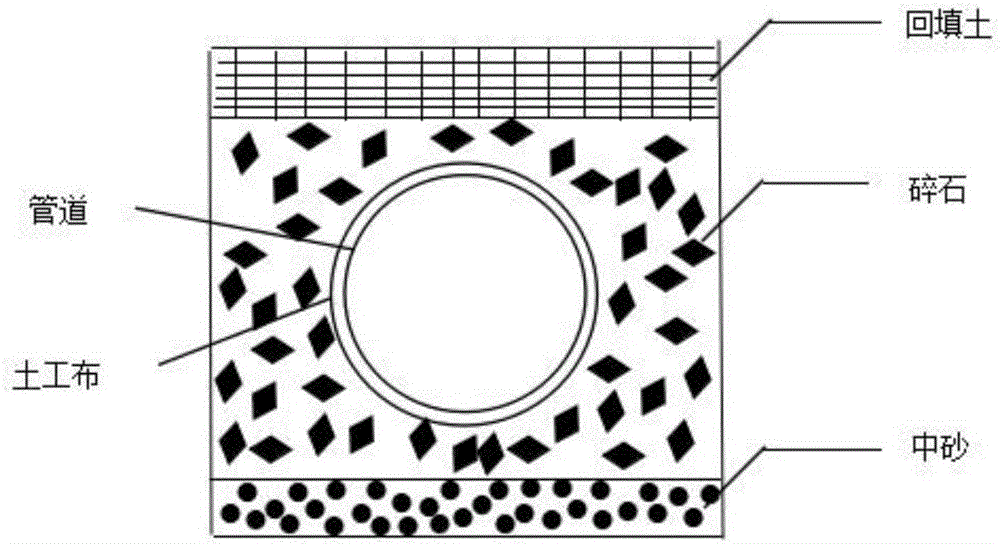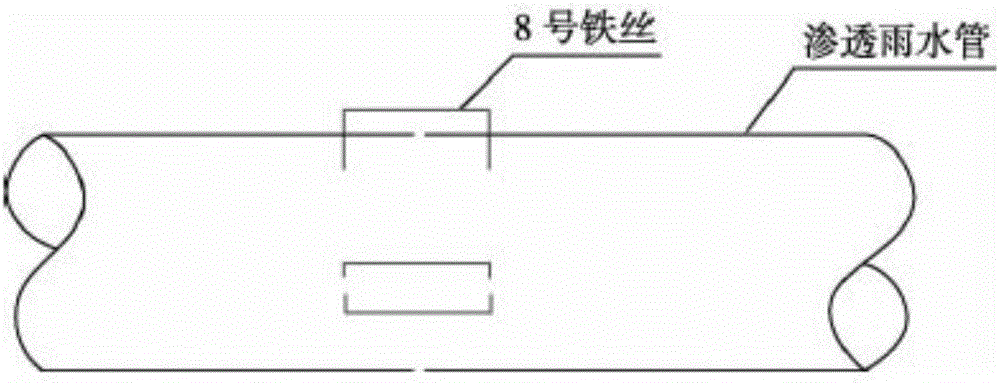Method for laying percolation type rainwater drainage pipes in Sponge City Construction
A rainwater pipe and percolation technology, which is applied in the sewer system, waterway system, road, etc., to achieve the effect of simple operation, environmentally friendly operation and safe operation
- Summary
- Abstract
- Description
- Claims
- Application Information
AI Technical Summary
Problems solved by technology
Method used
Image
Examples
Embodiment 1
[0025] A method for laying infiltration type rainwater pipelines in sponge city construction, the steps are as follows:
[0026] After the length of the route is measured, the grooves are manually cut, and the grooves are kept away from verticality and slopes are not set. Lay 10cm of medium sand that meets the specification size on the bottom layer, and tamp it down to make it smooth. According to the size of the trench and the length of the lap, determine the length of the geotextile, and then cut the geotextile. The geotextile should be laid flat, and the upper opening of the geotextile should be opened. After the paving of gravel is completed, the upper opening of the geotextile should be closed and overlapped. The particle size of the crushed stone laid at the bottom is 20-30mm, and the porosity is not less than 40%. The infiltration rainwater pipe is connected from the infiltration rainwater well. The diameter of the pipe is 150mm. The gap between the two infiltration r...
Embodiment 2
[0029] A method for laying infiltration type rainwater pipelines in sponge city construction, the steps are as follows:
[0030] After the length of the route is measured, the grooves are manually cut, and the grooves are kept away from verticality and slopes are not set. Lay 5cm of medium sand that meets the specification size on the bottom layer, and tamp it down to make it level. According to the size of the trench and the length of the lap, determine the length of the geotextile, and then cut the geotextile. The geotextile should be laid flat, and the upper opening of the geotextile should be opened. After the paving of gravel is completed, the upper opening of the geotextile should be closed and overlapped. The particle size of the crushed stone laid at the bottom is 20-30mm, and the porosity is not less than 40%. The infiltration rainwater pipe is connected from the infiltration rainwater well. The diameter of the pipe is 300mm. The gap between the two infiltration rai...
Embodiment 3
[0032] A method for laying infiltration type rainwater pipelines in sponge city construction, the steps are as follows:
[0033] After the length of the route is measured, the grooves are manually cut, and the grooves are kept away from verticality and slopes are not set. Lay 5cm of medium sand that meets the specification size on the bottom layer, and tamp it down to make it level. According to the size of the trench and the length of the lap, determine the length of the geotextile, and then cut the geotextile. The geotextile should be laid flat, and the upper opening of the geotextile should be opened. After the paving of gravel is completed, the upper opening of the geotextile should be closed and overlapped. The particle size of the crushed stone laid at the bottom is 20-30mm, and the porosity is not less than 40%. The infiltration rainwater pipe is connected from the infiltration rainwater well. The diameter of the pipe is 300mm. The gap between the two infiltration rai...
PUM
 Login to View More
Login to View More Abstract
Description
Claims
Application Information
 Login to View More
Login to View More - R&D
- Intellectual Property
- Life Sciences
- Materials
- Tech Scout
- Unparalleled Data Quality
- Higher Quality Content
- 60% Fewer Hallucinations
Browse by: Latest US Patents, China's latest patents, Technical Efficacy Thesaurus, Application Domain, Technology Topic, Popular Technical Reports.
© 2025 PatSnap. All rights reserved.Legal|Privacy policy|Modern Slavery Act Transparency Statement|Sitemap|About US| Contact US: help@patsnap.com


